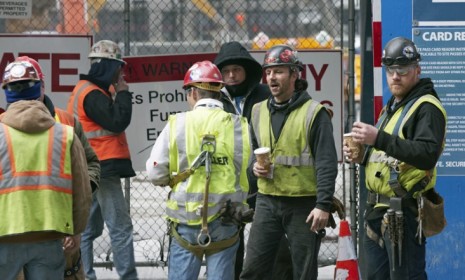America's blue-collar smoking trend: By the numbers
After years of interviewing Americans, the CDC finds that the nation's smokers are most likely to be young, poor, white — and working blue-collar jobs

Miners and food service workers have something in common: They both like to smoke. Teachers and business professionals, however, are among America's least likely smokers. Welcome to the new "collar-color divide," says John Gever at ABC, in which white-collar workers are much less likely to smoke than their blue-collar counterparts. Those are among the findings in a new study by the Centers for Disease Control and Prevention, which from 2004 to 2010 interviewed more than 113,000 Americans about smoking. Here, a look at more of the conclusions, by the numbers:
19.3
Percentage of U.S. adults who smoked regularly in 2010, according to the CDC
The Week
Escape your echo chamber. Get the facts behind the news, plus analysis from multiple perspectives.

Sign up for The Week's Free Newsletters
From our morning news briefing to a weekly Good News Newsletter, get the best of The Week delivered directly to your inbox.
From our morning news briefing to a weekly Good News Newsletter, get the best of The Week delivered directly to your inbox.
20.9
Percentage of U.S. adults who smoked regularly in 2005
$193 billion
Annual cost associated with lost productivity and health care for smoking-related illnesses, according to Reuters
A free daily email with the biggest news stories of the day – and the best features from TheWeek.com
30
Percentage of mining workers who smoke. The industry sits atop the CDC's rankings. And remember, says Gever, workers are "already at risk for respiratory diseases because of their occupational exposures."
30
Percentage of food service workers who smoke — tied with miners atop the CDC's list
29.7
Percentage of construction workers who smoke
9.7
Percentage of education workers who smoke — the lowest number on the CDC list
10.9
Percentage of business management workers who smoke
13.9
Percentage of finance and insurance workers who smoke
15.9
Percentage of "health care and social assistance" workers who smoke
28.4
Percentage of Americans with no high school diploma who smoke
9.1
Percentage of Americans with a bachelor, master, or other graduate degree who smoke
21.5
Percentage of white Americans who smoke — the highest rate of any ethnic group
17.9
Percentage of black Americans who smoke
23.8
Percentage of 18- to 24-year-olds who smoke — the highest rate of any age group
10.2
Percentage of those 65 and older who smoke — the lowest rate of any age group. In our "post-Mad Men world," Gever says, higher smoking rates are associated with "being poor or near-poor, uninsured, white, young, and male."
443,000
The number of deaths caused from cigarette smoking and exposure to tobacco from 2000 to 2004
42.4
Percentage decrease of adult smokers in the U.S. since 1965
Sources: ABC News, Boston Globe, CDC, Chicago Sun-Times, Medical News Today, Reuters, TIME

